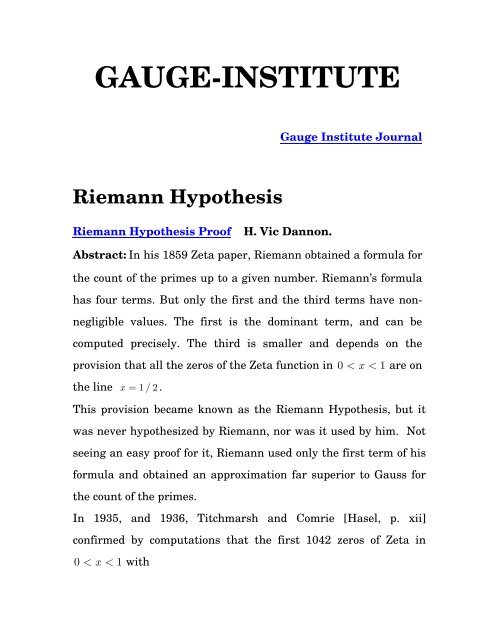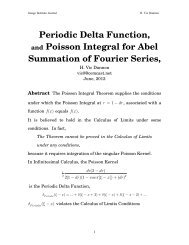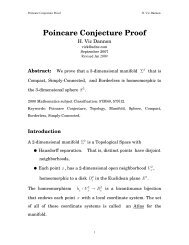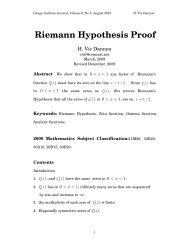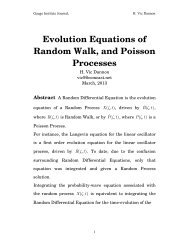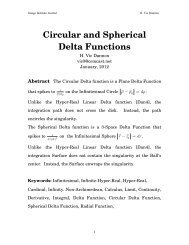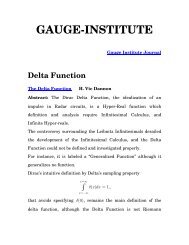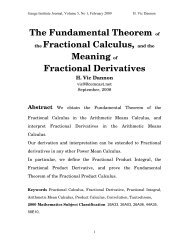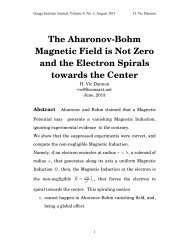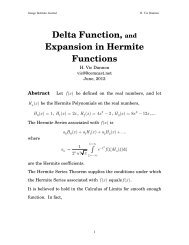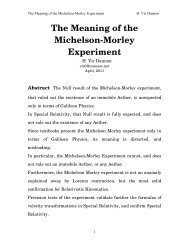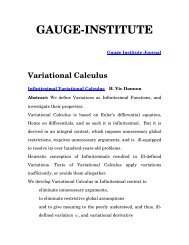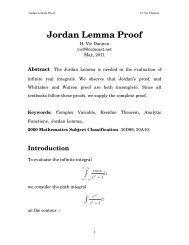Riemann Hypothesis - Gauge-institute.org
Riemann Hypothesis - Gauge-institute.org
Riemann Hypothesis - Gauge-institute.org
Create successful ePaper yourself
Turn your PDF publications into a flip-book with our unique Google optimized e-Paper software.
GAUGE-INSTITUTE<br />
<strong>Gauge</strong> Institute Journal<br />
<strong>Riemann</strong> <strong>Hypothesis</strong><br />
<strong>Riemann</strong> <strong>Hypothesis</strong> Proof<br />
H. Vic Dannon.<br />
Abstract: In his 1859 Zeta paper, <strong>Riemann</strong> obtained a formula for<br />
the count of the primes up to a given number. <strong>Riemann</strong>’s formula<br />
has four terms. But only the first and the third terms have nonnegligible<br />
values. The first is the dominant term, and can be<br />
computed precisely. The third is smaller and depends on the<br />
provision that all the zeros of the Zeta function in<br />
0 < x
0 < Imz<br />
< 1468<br />
lie exactly on the line x = 1/2. Following that, Touring (1953)<br />
extended the upper limit to Im z = 1540 , and Lehmer (1956)<br />
confirmed that the first 25,000 zeros of Zeta in<br />
lie on the line x = 1/2.<br />
0 < Im z < 21,944<br />
0 < x < 1<br />
with<br />
By 2002, the first 50 billion Zeta zeros have been located on the<br />
line<br />
x = 1/2, and in a 2008 meeting a far greater number was<br />
mentioned.<br />
The fact that the first 50 billion zeros are on<br />
x = 1/2, does not<br />
constitute a proof for the infinitely many zeros in the infinite area<br />
of the strip 0 < x < 1.<br />
But expecting massive endless computations to disprove the<br />
<strong>Riemann</strong> <strong>Hypothesis</strong> by finding a zero off the line<br />
x = 1/2, is<br />
statistically implausible.<br />
In fact, statistical tests indicate that the <strong>Riemann</strong> <strong>Hypothesis</strong><br />
holds with extremely high statistical certainty. In 2008, we<br />
applied a Chi-Squared Goodness-of-Fit-Test to the <strong>Riemann</strong><br />
formula for the count of the primes, and confirmed that the<br />
<strong>Riemann</strong> <strong>Hypothesis</strong> holds with certainty that is limited only by<br />
the software [Dan2].<br />
In sections 1 to 4, we present <strong>Riemann</strong>’s function<br />
ξ()<br />
z<br />
, and known<br />
facts about its zeros.
In section 5, we recall that ξ( x − iy) = ξ(<br />
x + iy)<br />
. This fact serves<br />
as a key result for the proof.<br />
In 8.2, we present a key result that follows from the Weierstrass<br />
factorization of<br />
ξ()<br />
z<br />
, and in 9.1 a key result due to Hadamard.<br />
The last key result due to Titchmarsh, is presented in section 10.<br />
There, we prove that in 0 < x < 1, any factor of ξ()<br />
z must have its<br />
zero on the line x = 1/2.<br />
Since ξ()<br />
z has in 0 < x < 1 the same zeros as ζ()<br />
z , this proves that<br />
all the zeros of ζ()<br />
z in 0 < x < 1, are on x = 1/2.<br />
<strong>Riemann</strong> Zeta Function: the <strong>Riemann</strong> <strong>Hypothesis</strong> Origin,<br />
the Factorization Error, and the Count of the Primes H.<br />
Vic Dannon.<br />
Abstract: <strong>Riemann</strong>'s 1859 Zeta paper defines the Zeta function<br />
and uses its properties to approximate the count of prime numbers<br />
up to a number t , and the density of the primes at the number t<br />
The few pages paper outlines a book that was never written by<br />
<strong>Riemann</strong>. The paper sums up <strong>Riemann</strong>’s results on the Zeta<br />
function, and on the count of the prime numbers, with a few<br />
connecting words, and no proofs/explanations.<br />
Attempts to write the book were made by Titchmarsh, and by<br />
Edwards, but none followed through <strong>Riemann</strong>’s writing.
Only by staying faithful to <strong>Riemann</strong>’s development of the Zeta<br />
function we can<br />
Get to the origin and meaning of the <strong>Riemann</strong> <strong>Hypothesis</strong>,<br />
Correct the factorization error,<br />
Apply <strong>Riemann</strong>’s Formula for the Count of the Primes,<br />
Acquire the tools needed for the <strong>Hypothesis</strong> Proof<br />
This is a detailed account of the <strong>Riemann</strong> Zeta paper.<br />
Chi-Squared Goodness-of-fit test of the <strong>Riemann</strong><br />
<strong>Hypothesis</strong> H. Vic Dannon<br />
Abstract The computing of the number of the primes up to a<br />
number<br />
x , started with Gauss who approximated it by the<br />
logarithmic integral.<br />
In his 1859 Zeta paper, <strong>Riemann</strong> obtained an intricate formula<br />
that uses all the zeros of the Zeta function on the line x =<br />
1<br />
, to<br />
solve the problem completely, provided that all the zeros of the<br />
2<br />
Zeta function in<br />
0 < x
This provision became known as the <strong>Riemann</strong> <strong>Hypothesis</strong>, but it<br />
was never hypothesized by <strong>Riemann</strong>. Not seeing an easy proof for<br />
it, <strong>Riemann</strong> used only the first term of his formula and obtained<br />
an approximation far superior to Gauss for the count of the<br />
primes. This term is known as the <strong>Riemann</strong> Approximation term.<br />
We shall refer to the third term that depends on the <strong>Hypothesis</strong>,<br />
and was neglected since <strong>Riemann</strong>, as the <strong>Riemann</strong>-<strong>Hypothesis</strong>term.<br />
Here, we will confirm that the <strong>Hypothesis</strong> holds with high<br />
statistical certainty, and the <strong>Riemann</strong> formula can be used with<br />
that high certainty.<br />
The uncertainty we found was way under<br />
10 −16<br />
. Indeed, the<br />
software produced certainty of 1.0. Consequently, we did not try<br />
to use many more Zeta zeros to obtain a lower uncertainty.<br />
Our computations indicate that if not for the limitations of the<br />
software, the <strong>Hypothesis</strong> can be confirmed to any degree of<br />
certainty.<br />
<strong>Riemann</strong>’s Formula for Count of the Primes: The effect of<br />
the <strong>Hypothesis</strong> Series<br />
H. Vic Dannon<br />
Abstract How many prime numbers up to 10?<br />
2, 3, 5, and 7 are the four prime numbers up to 10.
Lehmer have listed the prime numbers up to 10,006,721, and we<br />
can count with his list.<br />
A supercomputer was used to count how many primes are up to a<br />
Billion times a Trillion.<br />
But isn’t there some formula to replace counting?<br />
The computing of the number of the primes up to a number x ,<br />
started with Gauss who approximated it by the logarithmic<br />
integral.<br />
In his 1859 Zeta paper, <strong>Riemann</strong> obtained a formula for the count<br />
of the primes, that uses all the zeros of the Zeta function on the<br />
line x =<br />
1<br />
, to solve the problem completely, provided that all the<br />
2<br />
zeros of the Zeta function in<br />
0 < x
We shall refer to the third term that depends on the <strong>Hypothesis</strong>,<br />
and was neglected since <strong>Riemann</strong>, as the <strong>Riemann</strong>-<strong>Hypothesis</strong>-<br />
Series.<br />
It is obtained provided that all the zeros of the Zeta function in the<br />
strip<br />
0 < x
the <strong>Hypothesis</strong> Series convergence is<br />
unpredictable.<br />
Even with many <strong>Hypothesis</strong> Series terms, the convergence is slow.<br />
The Cesaro-Arithmetic-Means converge more smoothly but not<br />
faster.<br />
The slow convergence of the <strong>Hypothesis</strong> series, forces us to use<br />
statistics to estimate F(10 ^ 21) .


